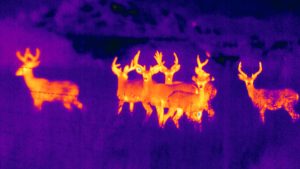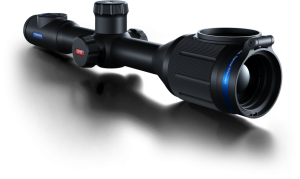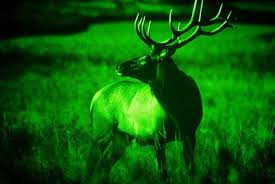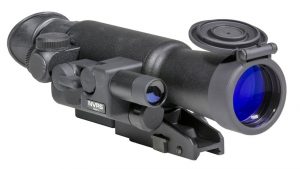Thermal Image Deer (click to enlarge)
Thermal Imaging Riflescope
There is an amount of misleading and erroneous “opinion” in circulation on the subject of use of night vision and thermal imaging devices in connection with hunting or “spotting” wild deer. It may be helpful to set out a clearer statement of the law in this regard.
Our starting point must be section 2 of the Wildlife Act 1976 as originally enacted.
Section 2 defines “to hunt” as: “[to] stalk, pursue, chase, drive, flush, capture, course, attract, follow, search for, lie in wait for, take, trap or shoot by any means whether with or without dogs, and, except in sections 28 and 29, includes killing in the course of hunting, but does not in this Act include stalking, attracting, searching for or lying in wait for any fauna by an unarmed person solely for the purpose of watching or of taking or making photographic or other pictures, and kindred words shall be construed accordingly”.
Section 28 of the Act provides for general restriction as regards hunting or killing with firearms certain exempted wild mammals and certain protected wild birds. Section 29 provides for the grant of licences to hunt with firearms. Neither section need be rehearsed here for the purposes of this analysis of the position as regards night vision or thermal imaging devices, which are covered under Section 38 of the Act, as amended.
The original section 38 of the Act as commenced in 1977 made it an offence for any person to
“use any lamp, light, torch, mirror or other artificial light-reflecting or dazzling device or appliance in hunting any protected wild bird or protected wild animal, otherwise than while either (a) attaching thereto any band, ring, tag or other marking device, or (b) hunting for educational or scientific purposes, pursuant to and in accordance with a licence granted under this Act by the Minister.”
Section 38 was amended by section 45 of the Wildlife (Amendment) Act, 2000 and now reads as follows:
“38.— (1) Any person who uses—
(a) any lamp, light, torch, mirror or other artificial light-reflecting or dazzling device or appliance, or
(b) any device for illuminating, image intensifying or heat seeking a target, or
(c) any sighting device for night shooting, or
(d) any device or appliance which is of a type, class or description specified in an order under subsection (2) of this section,
in hunting any protected wild bird or protected wild animal otherwise than while either—
(i) attaching thereto any band, ring, tag or other marking device, or
(ii) hunting for educational or scientific purposes or for any other purpose,
pursuant to and in accordance with a licence granted under this Act by the Minister, shall be guilty of an offence.
(2) (a) The Minister may by order declare a device or appliance which is of a type, class or description specified in the order to be a device or appliance to which subsection (1) of this section applies.
(b) The Minister may amend or revoke an order made under this subsection.”.
Sections 3 and 46 of the Wildlife (Amendment) Act, 2000 were commenced (brought into legal effect) on 12th March 2001 on foot of Statutory Instrument No. 71/2001 – Wildlife (Amendment) Act, 2000 (Commencement) Order, 2001. All other sections saving section 36 were commenced on 31st July 2001 under Statutory Instrument No. 371/2001 – Wildlife (Amendment) Act, 2000 (Commencement) (No.2) Order, 2001. Section 36 of the 2000 Act deals only with the regulation of commercial shoot operators.
It is clear then that use of any night vision or thermal imagery (heat seeking) devices to hunt wild deer (as defined in section 2 of the Principal Act) on or off the firearm, is strictly against the law, except for hunting for educational or scientific purposes or for any other purpose, under Ministerial licence.
The use of a lamp to hunt deer may be permitted under the terms of any section 42 licence provided the applicant or nominated hunter is HCAP-Certified.
It follows that use of any night vision or thermal imagery device may be permitted under the terms of any section 42 Licence. There is no barrier simpliciter, it would be for the licensing authority (NPWS) to determine acceptability of use of night vision or thermal imagery device in this context. However, in the context of hunting protected wild animals, such devices, on or off a firearm, are not permitted in any other circumstances. It is not an offence to possess or use such devices in any other legitimate context provided there is no breach of section 38 of the Act (as amended).
As always, the vermin shooting exclusion is there to confuse and confound the intention of the legislators.
In relation to the fitting of any such device to a firearm, the Garda Commissioner’s Guidelines (2018) carries the following statement:
(Quote)
TELESCOPIC SIGHTS
In the Firearms Act 1925 to 2009, the definition of a firearm additionally includes:
‘telescopic sights with a light beam, or telescope sights with an electronic amplification
device or an infra-red device, designed to be fitted to af irearm …. ‘ Such devices would
fall into three broad categories as follows and again an applicant must satisfy the issuing
person that he/she has demonstrated ‘good reason’ to acquire the sight:
(i) An Active Night Sight – this device emits an invisible light beam which
illuminates objects and would assist with identification of objects.
(ii) A Passive Night Sight – this device does not emit any beam but amplifies any
ambient light (from stars or moon) which enables objects to be distinguished
and identified.
(iii) Thermal Image Sight – this device resolves the heat signature given off by
warm objects and enables identification of objects.
When an applicant is applying for a firearm certificate or its renewal, the application
should include whether or not a silencer or telescopic sights are sought for that particular
firearm. A subsequent application for a silencer or telescopic sight will require the
applicant to re-apply on a new application form FCA 1 and will require the full €80 fee if
the application is successful. So it is vitally important, that where applicable, new
applicants or applicants applying to renew their firearm certificates ensure that their
application/renewal form includes reference to a silencer/telescopic sight. All firearm
certificates which include authorisation to hold a silencer, must include details of the
authorisation for the silencer in respect of the firearm by inclusion of the letter ‘S’ on the
firearms card.
(end quote).
Night Vision Image Deer (click to enlarge)
Night Vision Riflescope






